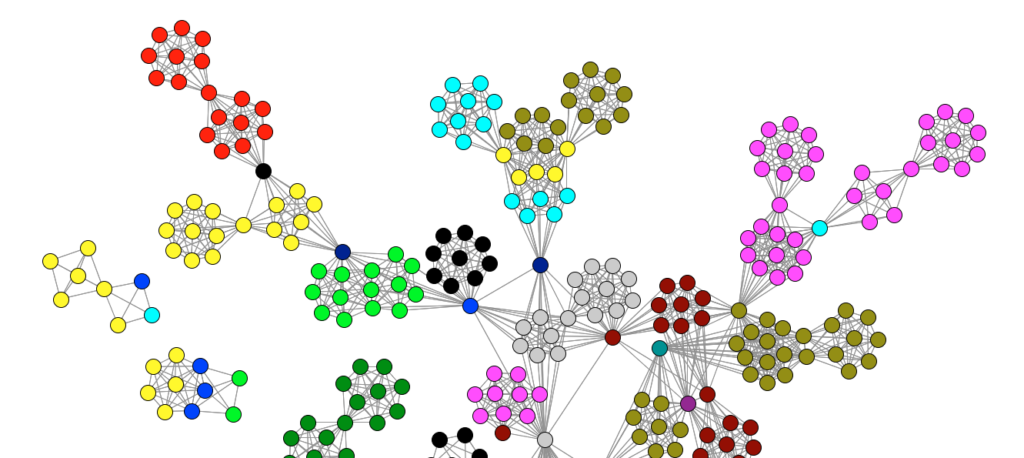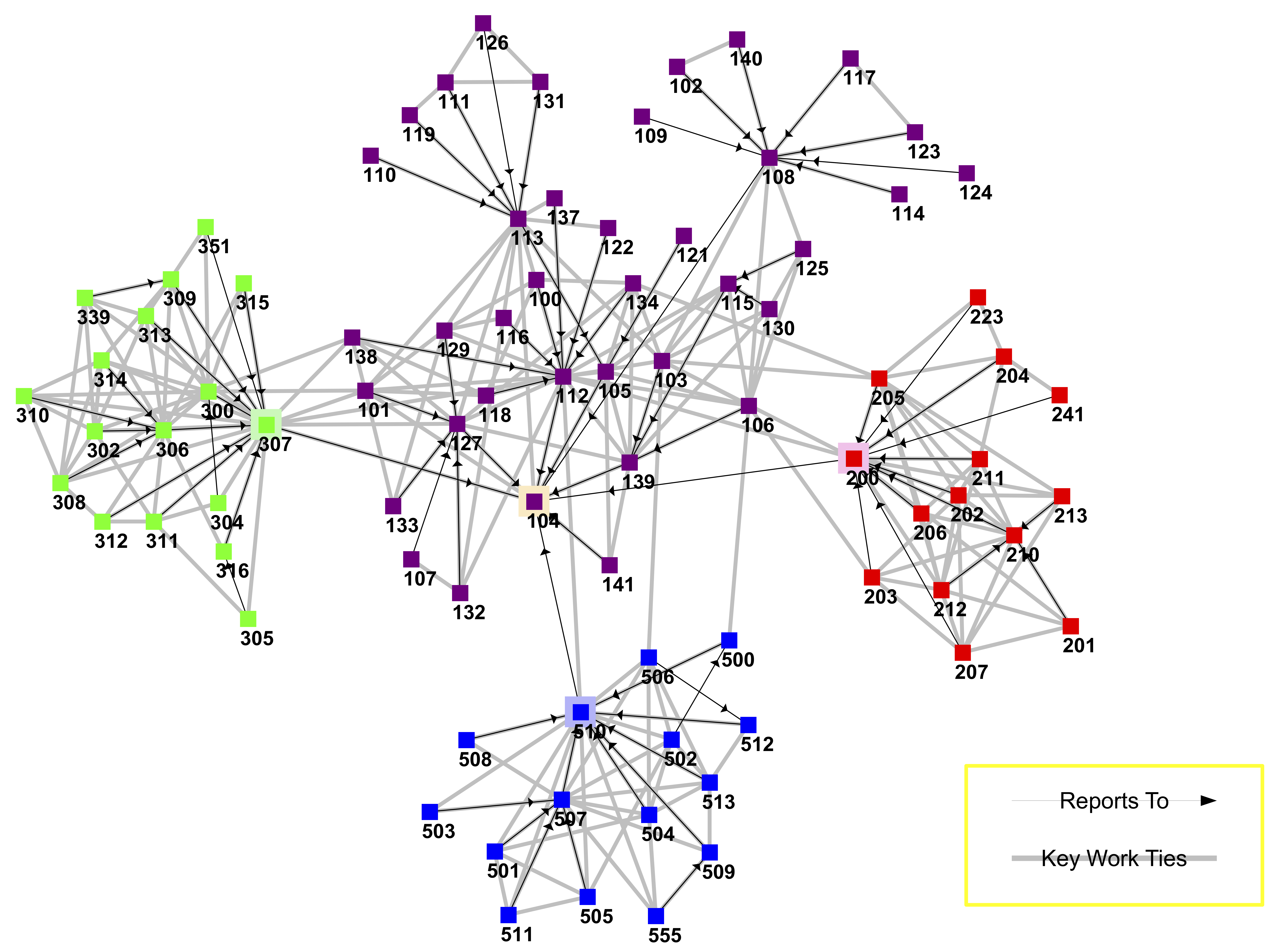Menu

Initially Dave and I each wrote a post around what see as important to discuss in the upcoming Exploratory. Part of what we are doing here is sense-making and now I am going to make sense of what David wrote and start a conversation on those topics.
Social and Organizational Network Analysis (SNA/ONA)
Reading through Dave’s first post I noticed his comments on SNA/ONA. Dave and I were first exposed to SNA/ONA at IBM in the 1990s. He was an internal IBM manager. I was an outside consultant who had developed a business-oriented SNA/ONA software tool that IBM Consulting Group (later known as IBM Global Services) was using for both internal and external consulting projects.
In the early days of SNA, data was usually collected by a non-anonymous network survey — everyone answered questions about everyone else in the group about work and project interactions. With whom do you exchange information/documents to get your job done? Who do you go to for technical assistance with the new computer system? We aimed to keep the questions work-focused and not personal realizing that people would have an easier time answering them. Yet, some consultants did not have a way with words and often asked very blunt survey questions like — Who do you trust? Do you feel high/low energy when you are with this person? As Dave points out, and I agree, asking questions such as these of people you work with daily, and others who make decisions about your company career is neither appropriate, nor safe. Survey respondents do not answer blunt questions about trust and energy honestly and truthfully about the people they work with every day, or supervisors they report to. Bad questions give you bad data.
So, how do we get data? The best way to get data on how work gets done in an organization or community is to look at the work artifacts left behind as people do their jobs. Who exchanges/edits the same documents, who is assigned to the same work teams, who exchanges work-related messages, who is in the same Slack groups or meetings? These artifacts reveal the emergent networks in the organization — how things really get done.
Many SNA consultants, and clients, view network maps and metrics as “report cards” — how are we doing? I suggest to my clients that question can best be answered in conversations that include both organizational members and outside experts huddled around network maps and metrics — exchanging feedback and making sense of what it all means. Social network maps and metrics are better used as “mirrors” and “talking documents” than report cards or performance reviews for Management. Our goal is for our clients to become better network-thinkers so that they can be better leaders in complex environments.
Social Network Stimulation(SNS) and Network Weaving(NW)
Once we figure out the “as is” picture of the networks in the organization/community how do we improve/change/strengthen our networks? Dave suggests SNS which he has found success with. I have never used this approach, so I look forward to learning more.
Orgnet LLC and our clients have found success with network-weaving — closing those triangles I mentioned in my first post. Looking at network weaving through a complexity lens, we see Stuart Kauffman’s adjacent possible which asks the question “what is possible by that which is adjacent, but not yet connected?” What if we connect two people, one who has solved a problem, and anther who is currently mired in a similar problem? What if combining technology X and technology Y, which already exist, enables technology/service/product Z to come into existence? How do we combine what is into what isn’t … yet?
Not all adjacent possibilities (closing of triangles) work out as intended. Some attempted connections go nowhere, others go elsewhere, some lie dormant until “one day…” and a few meet, or exceed, the potential that the connector had in mind. It is not just closing triangles that builds networks — we also need to open new triangles in fertile places of new and different knowledge and ideas. The network grows internally and externally. A combination of opening and closing triangles allows the human network to organize from the bottom up & inside-out, and build on what makes sense locally from many perspectives.
Network weaving also takes advantage of the scaffolding which is the current network structure. Networks are built on homophily — birds of a feather flock together. The people you are connected to (1 step in a network) probably share more similarities with you than differences. But those 2 and 3 steps away from you in a network start to tilt the scales to more differences (while still retaining similarities). This is where the opportunities lie — the opportune ties in the network! Here is where serendipity happens — where you meet someone new, or better yet are introduced to them, and find out that the other brings you the puzzle piece you were missing. Bridging two and three step paths in networks makes entrepreneurial networks vibrant and spans silos in organizations. Serendipity awaits you in the outer reaches of your network neighborhood.
Mycorrhizal networks
Mycorrhizal networks work to connect the unconnected in places we don’t imagine there are many connections. Mycorrhizae makes forests and other plant ecosystems vibrant. A recent NYT article, “The Social Life of Forests” explains how mycorrhizal networks connect trees in a forest and provide pathways for the sharing of nutrients and even messages amongst trees in a network neighborhood. It is fascinating how mycorrhizae play the role of intermediary in the forest. What is analogous to mycorrhizae in human networks?
What intermediaries do we use to communicate and share resources? Is the Internet like a mycorrhizal network? The Internet is not alive like Mycorrhizae, but it does self-organize(with our help) like the mycorrhizal networks in the forest soil. In a post-Covid world we will be able to all come together in a common place and interact without any technical intermediary — F2F will be safe again. Unlike trees and plants we do not need Mycorrhizae to interact while we are in physical proximity. The technical equivalent of mycorrhizal networks are necessary when we need to communicate at a distance.
Will AI of the future create self-organizing (mycorrhizal-like) networks that connect the right people and projects with the right information and resources in what will be our organizations and communities of the future?
Wording
One last comment. Many people use the terms informal network and formal network to refer to the connections we have in organizations. We have found that many organizational members scoff at “informal” networks and liken them to “the grapevine” and “the rumor mill”. If it is informal it can’t be important they think. Is this lingo from the last century — not fitting the 21st century economy?
We have been using “prescribed networks” to refer to the organizational hierarchy and the assignment of people to projects and processes. Emergent networks, works well with our complexity lens, and shows the non-engineered, non-designed, nature of human networks that happen and grow over time as people work or live together. Below is a network map from one of our client organizations showing both the prescribed and emergent networks. We see how the prescribed and emergent networks entangle to get work done.

Please join us for further sense-making of our connected communities and organizations in the upcoming Exploratory during Feb-March 2021.
Cognitive Edge Ltd. & Cognitive Edge Pte. trading as The Cynefin Company and The Cynefin Centre.
© COPYRIGHT 2024

Anyone starting to get interested in complexity theory will sooner or later come across various ...